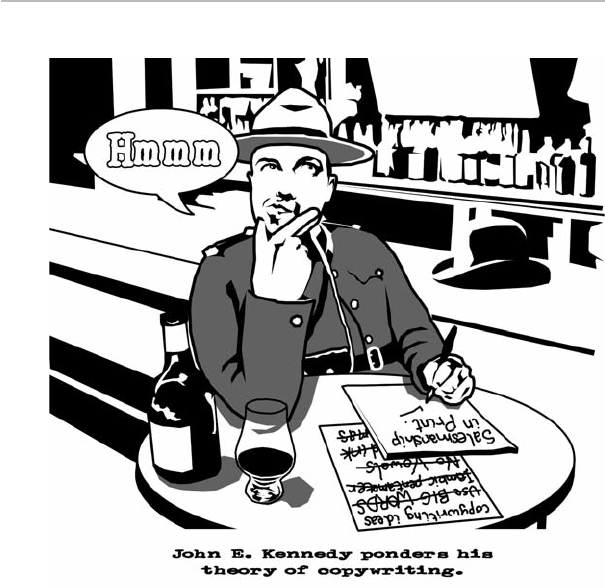Preface
In the beginning
In the late 1890s a Canadian Mountie named John E. Kennedy
hung up his hat, handed in his gun and did what any rock-jawed
law enforcement operative would do in similar circumstances –
he got into advertising. Not just any advertising, mind. Kennedy
was concerned with copy. The advertising agencies of his day
employed plenty of people called copywriters, but their craft was
far from fully defined. Kennedy had thought long and hard
about how words could be made to work harder. He realised the
burgeoning advertising industry was missing a trick and that he
was the man to put things right. So that’s exactly what he set out
to do.
Fast-forward a few years to a May evening in 1904. Kennedy is
seated in a Chicago saloon. He scribbles a brief note to the
directors of an advertising agency that occupied the upper floors
of the building. According to legend the note read:
I am in the saloon downstairs. I can tell you what advertising is. I
know you don’t know. It will mean much to me to have you know
what it is and it will mean much to you. If you wish to know what
advertising is, send the word ‘yes’ down by the bell boy.
Somehow the note made it to Albert Lasker, one of the agency’s
junior partners. Lasker was getting ready to go home for the
evening but was sufficiently intrigued by its chutzpah to invite
the impudent Kennedy upstairs for a chat. Most people would
A01_HORB7347_01_SE_PRELIMS.QXP:A01_HORB7347_01_SE_PR 5/6/09 10:59 Page xi

have written Kennedy off as an over-refreshed punter and asked
security to have a quiet word. Not Lasker. To his credit (and
indeed immense enrichment) he saw something in Kennedy’s
scrawl worthy of investigation, and by the time the two of them
parted in the early hours of the next day nothing in copywriting
would be the same again.
During that meeting Kennedy revealed to Lasker his big insight
– that copywriting is ‘salesmanship in print’. Nothing more,
nothing less. He complained that adverts didn’t need to be
‘charming or amusing or necessarily pleasing to the eye’ but
instead they should be a ‘rational, unadorned instrument of sell-
ing’. The copy should talk neither down nor up to its reader;
instead it should address them in a way that left them ‘open to
appeals made by sensible arguments’.
xii Preface
A01_HORB7347_01_SE_PRELIMS.QXP:A01_HORB7347_01_SE_PR 5/6/09 10:59 Page xii

All of this sounds eminently sensible until you start to dig a little
deeper. Kennedy’s hard-headed ‘salesmanship in print’ is a great
start, but it’s only half the story. Take this approach too far and
pretty soon copywriting becomes
cold and unconvincing. People rarely
buy for wholly rational reasons, and
in many cases copywriting that is
‘charming or amusing’ can outperform its rational relation. Not
that you’d know it from the lacklustre copy put before today’s
long-suffering public. The sad fact is that although selling and
salesmanship derive much of their power from brilliant copy-
writing, most copywriting is far from brilliant. In fact most of it
doesn’t really work.Why? Because no one reads it.Why? Because
it’s boring. Or bad. Or just plain irrelevant.
Sorry, but it’s true.
Most copy isn’t written with the reader in mind. It doesn’t
answer their questions, speak their language or tickle their fancy.
And copy that isn’t written for its reader is almost certainly des-
tined to fail.
Trying to browbeat your audience
into submission through a toxic mix
of dull writing and endless repeti-
tion is a desperate, wasteful
strategy. The answer is to Make It
Interesting, my highly presumptuous
update to Kennedy’s three-word formula for success. If this
book has one main message it’s that brilliant copywriting
almost always appeals to its readers for reasons other than pure
reason – in other words Kennedy’s rationalist ‘reasons to
believe’ approach must be tempered with whatever it takes to
capture the reader’s imagination, and that usually means intro-
ducing something softer, more emotional, and above all
interesting.
Preface xiii
rational is good;
emotional is better
brilliant copywriting
almost always appeals
to its readers for reasons
other than pure reason
A01_HORB7347_01_SE_PRELIMS.QXP:A01_HORB7347_01_SE_PR 5/6/09 10:59 Page xiii
xiv Preface
About this book
Who it’s for
In the past copywriters worked for advertising agencies; today
they crop up in all manner of creative companies. Consequently
this book is aimed at anyone who uses words to persuade or sell.
You might work in advertising, design, branding, PR, jour-
nalism, marketing or sales; equally you might be a manager
interested in how copy works, a student who wants to break into
copywriting, or a teacher looking for course material. All are
welcome here. The only thing that unites the many different
tribes for whom I wrote this book is that they want to improve
how they persuade in print.
That last point is important. The copywriting I describe is pri-
marily for page and screen; if you need to know about the
specialised task of copywriting for TV, radio, outdoor and so
on there are several excellent books listed in the Bibliography
and Further Reading section at the back. This book focuses on
what I’ll describe as marketing copywriting. However, I
happen to believe that writers working in design, branding,
business and so on have much to learn from our colleagues in
advertising, a hunch that I hope is borne out in the various
interviews with advertising people towards the end. No group
has a monopoly on knowledge; the more we share, the more
we all benefit.
What’s inside
This book is divided into three parts: Background, Method and
Interviews. Where possible the emphasis is on doing. That’s one
of the great things about copywriting – you create stuff. In my
opinion the pleasure of turning in a great piece of copy – any-
thing from a short phrase to a lengthy think-piece – can make all
the dead ends, rejections, delays and general nonsense that come
with the job worthwhile.
A01_HORB7347_01_SE_PRELIMS.QXP:A01_HORB7347_01_SE_PR 5/6/09 10:59 Page xiv

Inevitably this book contains all sorts of, well, not rules, let’s call
them principles and methods. Some free spirits will say such
things act as a brake on brilliant copy.That’s a nice idea, but like
many such ideas it’s bunk. Without a sound knowledge of the
nuts and bolts of brilliant copywriting the chances are that a
writer, even a naturally talented one, will produce a load of self-
indulgent poppycock. It’s the old saw about having to know the
rules in order to break them. So if at times I sound slightly
didactic I make no apology.
On being brilliant
For me, ‘brilliant copy’ is simply copy that works – it grabs the
reader’s attention, gets its message across and persuades them to
act – and it does all that with economy, wit and style. At the end
of Part 2 I’ve included examples of
just such copy, drawn from work I’ve
done over the years. This is not –
repeat, not – because I’m incredibly
pleased with myself. One peek into
the seething pit of torment that is my
creative soul would soon convince
you otherwise. No, it’s simply that this material helps me make
the points I need to make without any wearisome copyright
issues.
And while we’re on the subject of confessions, let’s have another.
Can this book – any book – really make you a brilliant copy-
writer? I truly don’t know. What I do know is that what follows
will give your copywriting career a rocket-assisted launch.You’ll
learn how some really great writers go about their business and
you’ll pick up all sorts of tips and tricks that would otherwise
take years to acquire.The rest – realistically – is up to you.That’s
fair enough, isn’t it?
Preface xv
brilliant copywriting
grabs the reader’s
attention, gets its
message across and
persuades them to act
A01_HORB7347_01_SE_PRELIMS.QXP:A01_HORB7347_01_SE_PR 5/6/09 10:59 Page xv
..................Content has been hidden....................
You can't read the all page of ebook, please click here login for view all page.
